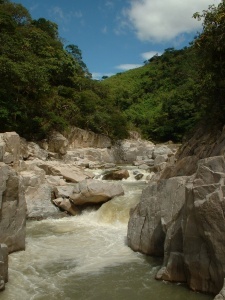 rivers | guidebooks | forums | tips | other
rivers | guidebooks | forums | tips | other
Class: IV, V/V+ ; Flow: 250-3,000 cfs; Ave. Gradient: 7 m/km Upper, 22 m/km Las Pavas; Portages: yes; Length: 20 + 6 km; Time: 4 + 4 hours
Season: June to October ; rafts? Upper; Highlights: challenging gorges; Crux move: challenging gorges
PI: Citalá (707 m); TO: Las Pavas (562 m) or Lempa (428 m)
Description: (click here for general notes about my descriptions)
The Upper Lempa is classic Central American class IV/V creeking in a secluded canyon. The pool-drop rapids are varied and high quality, with some drops getting quite big. The river serves up some challenges to everyone, especially if you brave the Las Pavas canyon, yet when it gets too challenging, there is always a portage option over the boulders (though not always an easy one). When boat scouting, I recommend doing so with an abundance of caution since I found several rapids drawing me in a little too close for comfort.
A full description is in the Mayan Whitewater El Salvador, Honduras, & Nicaragua guidebook.
Descent History: The first descent of the Ruta del Jaguar was in 1993, organized by Ríos Tropicales (Costa Rica) explorers Jimmy Nixon, Mauricio Bicard, and an unknown Argentinian. (Jimmy sustained a serious injury requiring a next-day extraction.) The first raft descent was in October 2003 with Ríos Aventuras honcho Rafael Leret and guides Beris and Noé and three others, taking 2 days from Ocotepeque, Honduras, to Lempa (of course portaging multiple rapids in the Las Pavas section).
Flow Notes: This river has fairly reliable water during the rainy season. There is an online gauge right at the PI, though it stopped working in 2020 (in the past, readings over ~0.8 gave creeking flows.) You also have the El Zapotillo gauge further down the river but note this measurement also includes the Río Guajoyo flow. History for that gauge is shown on page 46. I do not have its correlations for lower creeking flows (in 2022, a 1.9 reading gave 3,000 cfs at Citalá). This river has a large drainage and can get big and burly. The Upper can be run at quite high flows but Las Pavas demands more and harder portages the higher it gets. In addition, the flash flood danger in Las Pavas is extra high.
 |
 |